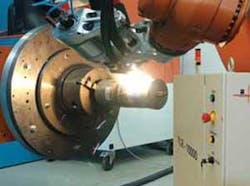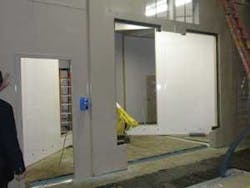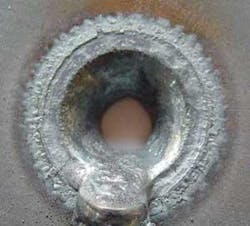LASER SAFETY EQUIPMENT: Fiber lasers present new safety challenges
THOMAS J. LIEB, WILLIAM ERTLE, and JOHN “JAY” PARKINSON
Integration of fiber lasers into material-processing systems has presented new challenges to engineers trying to comply with the requirements of the U.S. Food and Drug Administration’s Center for Devices and Radiological Health (CDRH) or other international laser standards such as the International Electrotechnical Commission (IEC).1, 2 Challenges include the provision for a physical beam stop or attenuator, emission indicator, and adequate protective housing. Fortunately, new developments, such as active-guard technology, or new applications of existing technology may prove helpful.
Fiber-laser safety
The beam delivery fibers of many fiber lasers are optically fused with the actual fiber laser—a design that leads to several laser-safety compliance concerns (see Fig. 1). First, laser manufacturers frequently provide these lasers as CDRH-registered component products, meaning they are defined as a “component,” not a fully certified laser or system product. Component products are not required to have all the features of certified laser products—many fiber lasers do not have a safety beam attenuator built in, for instance. Hence, a physical safety shutter must be added by the system integrator, or end-user, before the final system is CDRH certifiable. Typically, integrators solve this issue, at some expense, by incorporating a commercially available shutter into the final beam delivery element or end-effector.
Second, fiber lasers designated as “components” require integration of process interlocks. Usually a fiber laser has a remote interlock connector (RIC) built into it. As required, when you open-circuit the RIC the laser requires a manual reset. This function is fine in a lab, but not always desirable in automation. Some designers work around this issue with a programmable logic controller (PLC) common to industrial control systems to provide a “laser trigger” signal. Many such configurations do not satisfy safety requirements, as trickle energy can be present if the laser has a master oscillator. In such cases, there can be constant energy in the pump-laser diodes that exceeds Class 1 limits. Unless there is a physical block, this energy can be accessible when the operator might falsely assume it is safe.
A third issue involves adequate conformity to protective housing requirements for delivery fiber. Protective housings must prevent human access to any and all laser radiation in excess of Class 1 that is not necessary to the function of the product. In this regard, the flexible sheathing over the fiber core can be viewed as a “protective housing” of sorts. In the U.S., protective housings must perform their function under operating conditions throughout the usable life of the product.
Unfortunately, many fiber-laser makers are unaware of this issue or assume the integrators will address it. Options include enclosing the entire fiber path inside the Class 1 system enclosure (thus the outer housing acts as the second layer of fiber protection), creating an active-sensing circuit to detect fiber breakage, or encasing the fiber-optic cable in a metal jacket to prevent fiber damage or access to laser light if the fiber does break.
Walk-in workstations
Large-scale applications in laser processing require even more protective housings around large robots or five-axis beam manipulators. At the same time, the high beam quality inherent to fiber lasers has permitted application developers to use longer focal lengths so longer stand-off distances can facilitate complex-geometry processing of large parts. Individually and together these phenomena raise new areas of safety and compliance concern.
Typical walk-in workstations involve a laser protective housing large enough and constructed to allow reasonable human access inside the enclosure. Safety requirements for these workstations are somewhat consistent worldwide and can be summarized as follows: if a workstation contains an embedded Class 3B or Class 4 laser, where “walk-in” access is intended or reasonably foreseeable, then emission of laser radiation that is equivalent to Class 3B or Class 4 shall be prevented by engineering means when someone is present inside the enclosure (see Fig. 2). Additionally a person inside the housing must be able to prevent activation of the relevant laser hazard, and a warning device must be situated so as to provide adequate warning of emission of laser radiation. Methods used to meet walk-in workstation requirements include the use of laser scanners, light-curtain configurations, safety mats, and/or people counters.Laser scanners are sweeping transceivers that can detect presence and provide a signal to shut down the laser. Their primary assets are high zone coverage and accuracy. Drawbacks include the fact that they are easily confused by motion systems (robots) that are part of the process, and they can be very expensive to implement—especially where internal structures form blind spots requiring multiple scan units to accomplish full coverage.
Light-curtain configurations are widely used in industrial applications as noncontact barriers for motion systems or other hazards. These “electric eye” or beam-interruption devices have been configured to trigger when someone breaks through the light within walk-in workstations. The technology is well known in industry, and the cost is moderate. However, because they work only in one plane and the beam is static, careful design effort is required to plan an effective control function–sometimes requiring many devices and raising the cost.
Safety mats are widely used to protect people inside hazard zones. Their prevalence makes them easy to implement, and they can be inexpensive. However, many fiber-laser workstations have multiple planes upon which humans stand, or sit, when performing work inside the workstation. This means mats would have to be applied to nearly every horizontal surface, again increasing the cost and complexity.
People counters—devices that count the number of persons entering or leaving a structure—were previously limited to high-security applications. The detector systems and software are highly sophisticated, customized to location, and expensive. Recently a concept was developed—using relatively inexpensive detectors (sold for commercial applications) coupled to standard safety-rated PLCs—that determines the number of people entering and compares that against the exiting number to establish that nobody remains inside. Part of the development was to define configurations of the detectors and software to resolve “tail-gating” or multiple-abreast entry. This method may offer a broadly adaptive and comparatively inexpensive alternative or augmentation to mats, light curtains, and scanners.
Long focal lengths
Enabled by fiber lasers, long focal lengths are an issue in the design of protective housings, both small and large. Protective housings, in the U.S., must provide Class 1 protection over the life of the product. In the international arena the requirement includes the “reasonably foreseeable single fault” stipulation, and IEC 60825-4, Laser Guards, specifies the amount of time that a laser guard (protective housing) must withstand the expected energy, depending on usage and environment.
Typical methods for designing the protective housing include determining the point at which the expected energy can do harm to the panel or component. In robotic or five-axis beam delivery systems, this includes “what-if” analyses of situations where malfunctioning software or human error permits the robot to point the beam directly at a wall (see Fig. 3). In this situation, design solutions include moving walls beyond the melt point, making extra heavy-duty walls or wall materials, double-panel walls, or active guards (guards or walls that have a built-in sensor to detect when hazardous radiation is incident and provide a signal to shut down the laser).With the advent of very long focal lengths (±1 m), very high power (multikilowatt), and very high-quality (low M2) fiber lasers, these techniques need refinement. Often, there is no material that will withstand high-irradiance beams of several kilowatts; nor is it often practical to move the walls far enough away, in four directions. A possible solution is being developed in Germany that is easy to implement and cost effective.3 It involves making ordinary guarding material (sheetmetal) into active-guard components by application of a proprietary coating and providing the signal through a PLC to prevent emission of the laser (when the temperature rises but before the melt temperature of the material is approached). Guarding made from this process could be available in late 2009 or early 2010.
Ultrashort-pulse lasers
Femto- and picosecond pulse lasers offer wavelength profiles for transmission and absorbance bandwidth that can be inherently different from more conventional lasers of the same medium.4 Essentially, high peak powers of ultrafast lasers can prove hazardous to personal protective equipment intended for conventional laser sources, not to mention that some recent tests suggest that single-photon saturation nulls the doped filter materials in laser-safety eyewear. Suppliers are responding and providing protective gear on a case-by-case basis to meet these challenges.5
REFERENCES
- CDRH Title 21, Chapter 1, Subchapter J, Part 1040–Performance standards for light-emitting products; Section 1040.10 Laser products; www.accessdata.fda.gov/scripts/cdrh/cfdocs/cfCFR/CFRSearch.cfm?FR=1040.10.
- IEC 60825, Ed. 2; list at www.iec.ch.
- S. Kühn et al., Proc. ICALEO 2008, Temecula, CA, paper 208 in the Laser Materials Processing Conf. (Oct. 20, 2008).
- M. Lenner et al., Optics Express 12(7) p. 1329 (April 5, 2004).
- D.S. Moore, Los Alamos National Lab LSO Workshop (July 2008).
Thomas J. Lieb is president of L•A•I International, 8864 Mannington St., Elk Grove, CA 95758-6347; e-mail: [email protected]; www.lai-international.com. William Ertle is president of Rockwell Laser Industries, 7754 Camargo Rd., Cincinnati, OH 45243; www.rli.com. John “Jay” Parkinson is president of Phoenix Laser Safety, 333 N. Pennington Dr., Unit 67, Chandler, AZ 85225; www.lasersafetyconsultant.com.


